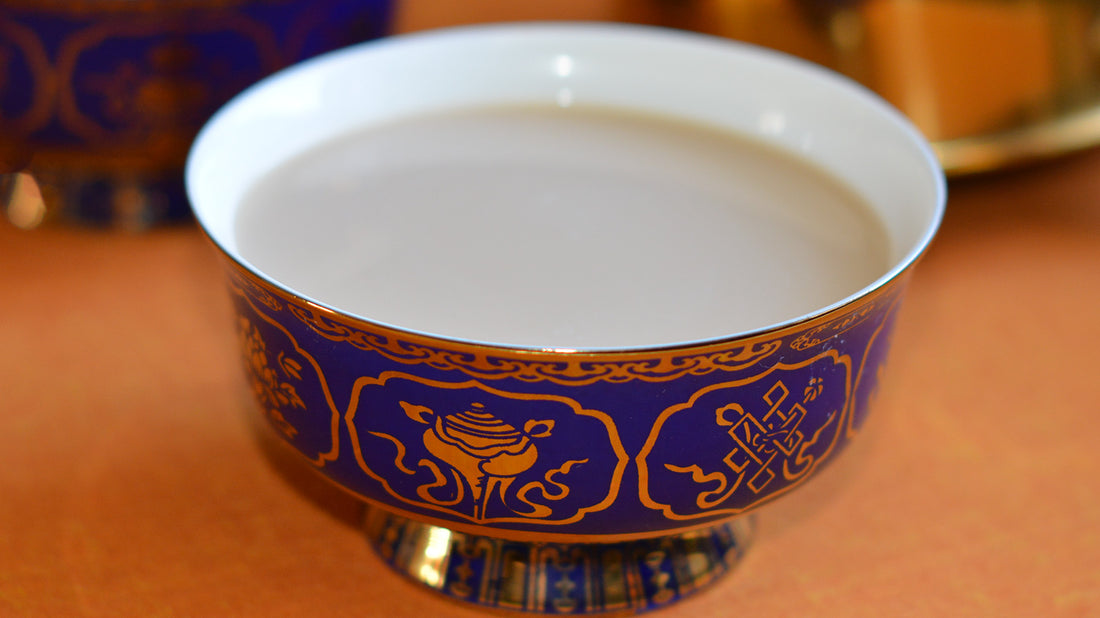
Warm Wishes & Warm Tea: Sharing Amdo Tibetan Milk Tea This Holiday Season
Share
As the crisp air settles across North America and echoes the chill of my homeland in the Far East, I'm drawn to the comforting warmth of a time-honored tradition: Amdo Tibetan Milk Tea. It isn't just a beverage; it's a daily ritual steeped in history, tradition, and hospitality.
A Legacy Steeped in Tradition
Milk tea holds a special place in Tibetan society. Dating back over 1,300 years (Source: Columbia University, Mud & Leaves), its origins can be traced to the Tang Dynasty. Princess Wencheng's marriage to the Tibetan King, bringing tea to the Tibetan plateaus. It became a vital part of life, consumed for its taste and health benefits—a rich source of antioxidants, vitamins, and minerals.
Across the Tibetan Plateau, tea traditions vary significantly. While milk tea, as described here, is a staple, other regional variations offer unique flavor profiles. In some areas, particularly around Lhasa, milk tea is enjoyed with a touch of sweetness. The most known variation in the West is butter tea (po cha), a savory beverage made by churning tea with Dri's butter (female yak) and salt. This drink provides much-needed energy and warmth in the high-altitude regions of Tibet.
Butter tea is essentially made by adding butter and salt to a base of milk tea, similar to the Amdo preparation, and churning it all together.
A Regional Twist: The Unsweetened Charm of Amdo
Across the vast Tibetan landscape, milk tea takes on regional variations. While the Lhasa region embraces the sweeter and richer, savory flavor of butter tea, Amdo (my home region) celebrates the raw, natural essence of the tea. Here, families brew daily in a large kettle of unsweetened tea, incorporating milk from "Dri" (female yak), dzo ("Zhomo" – a yak-cattle hybrid), or even cows and goats, depending on availability.
A Ritual of Connection
The offering of milk tea is an act of hospitality in Tibet. Whether a guest arrives unexpectedly or a family gathering unfolds, the kettle sings its warm welcome. This ritual transcends cultures; Mongolians, Hui Muslims, and even Han Chinese residing in the Rebgong Valley have embraced this tradition.
A Pinch of Personalization: Embracing Variation
While tradition leans towards unsweetened tea in Amdo, my grandmother, like many in the region, did not add salt or sugar. However, she did incorporate ground walnuts for a unique, nutty richness. I sometimes add a pinch of salt and sugar. This subtle addition indeed creates a complex flavor profile, neither sweet nor salty but full-bodied. (Adding and churning butter and salt transforms this milk tea into a distinct Tibetan butter tea.)
I encourage you to experiment! Explore the taste with or without the optional pinch of salt and sugar, and definitely try it with the walnuts or butter.
Making Memories, One Sip at a Time
The aroma of brewing milk tea brings back cherished memories of my childhood—family and friends gathered around a crackling traditional fire, sharing stories, singing, and laughing fueled by this soul-warming drink served in 8 auspicious design bowls.
The beauty of Amdo Milk Tea lies in its simplicity. All you need are basic ingredients – black tea, milk, and your choice of salt, sugar, and nuts.
Below is the recipe to recreate this heartwarming tradition in your own kitchen.
Amdo Tibetan Milk Tea Recipe
INGREDIENTS
- 6 cups water
- 4–5 black tea bags (or 1 ½–2 tablespoon fresh loose black tea)
- 2 cups whole milk
- ⅓ cup crushed walnuts or pecans (optional)
- ⅓ teaspoon salt (optional)
- 1 tablespoon sugar (optional)
METHOD
- Bring water to a boil in a covered pan.
- If using nuts, add them to the boiling water and simmer over medium-low heat for 5-8 minutes.
-
Add tea bags or loose tea and simmer for 2 minutes.


-
Pour in milk, salt (if using), and sugar (if using). Increase heat to high & bring to a gentle boil.

- Remove from heat and let steep for about 3 minutes, allowing flavors to meld.
- Strain out tea bags and nuts (if used).
- Serve hot. Store leftovers in a thermal carafe for further enjoyment throughout the day.

TIP: Adjust the ratio of water to milk based on your preference. Use 3 cups water to 1 cup milk.
Beyond the Cup: Pairing Perfection with Amza Superfoods
Amdo Milk Tea pairs beautifully with several Amza Superfoods offerings.
Add a warm touch to your No-cook Tsamba Breakfast Mix with Nuts & Dates.
Pair it with our Tibetan Tsamba Balls with Oregon Hazelnuts and Tsamba Truffles with Dark Chocolate.

Above is No-cook Tibetan Tsamba Breakfast with Nuts & Dates made with Amdo Milk Tea topped with berries.
Embrace the warmth, the history, and the simple joy of this Amdo tradition. Let Amdo Milk Tea become your daily ritual for connection and comfort.
Wishing you all a very happy holiday!
Warmly,
Jolma
P.S. If you like this post and want to support us, there are 4 ways!
PICK ONE right now before you forget:
